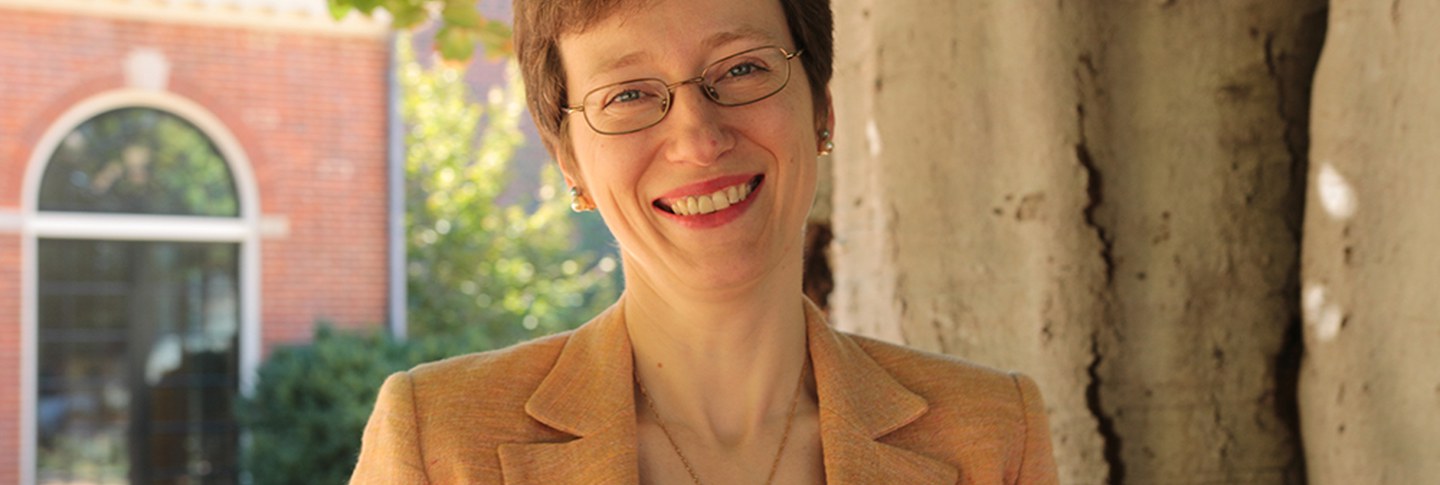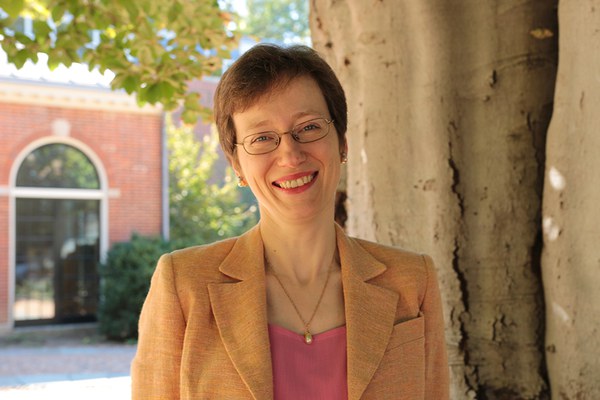“Strange images find me,” says Elena Boeck. She pauses briefly before continuing: “I think I have a natural affinity for outlying images.”
“Strange” and “outlying,” “liminal” and “borderline”—these words crop up frequently when Boeck, who recently began her five-year tenure as director of Byzantine Studies, speaks of her work. Perhaps because her research centers on the odd, out-of-place, and oftentimes mysterious visual clue, her way of speaking is staunchly investigative; her sentences advance steadily and logically, extended every now and then by a favorite phrase: “This is why . . .”
Professor Boeck comes to Dumbarton Oaks from DePaul University, where she holds a professorship in art history. She received her BA in that subject in 1996 at Boston University, followed by an MA and PhD at Yale. After completing her PhD in 2003, Boeck quickly settled at DePaul, where she has taught in various capacities since 2004. In addition to her scholarly work, Boeck brings strong administrative experience to her directorship at Dumbarton Oaks; she served as principal organizer of the 2011 Byzantine Studies Conference, and as a member of the governing board of the Byzantine Studies Association of North America between 2008 and 2012. (Having reassumed this position in 2015, she will now serve until 2019.)
Boeck, who hails from Riga, Latvia, originally intended to study physics before coming to the United States to pursue her undergraduate studies. But once she arrived, a natural inclination to the study of images drove her to major in art history. (Her conversion to Byzantine art history came later, during a trip to Istanbul).
Despite what might seem a jarring shift, she insists there are strong parallels between the fields: “In physics, one studies laws which have been made manifest in physical form . . . and the same thing applies to art history. Objects have a created reality, but there are laws and rules and there are structures—the creator’s intellectual processes—which bring them into existence.”
Boeck’s fascination with the hidden origins of images, and her belief that precise ideological structures often stand behind the art that surrounds us, are perhaps not so surprising, given the environment of her youth. “The other side of the story,” Boeck says, matter-of-factly, when explaining her proclivity to art history, “is that I grew up in the Soviet Union; I’ve seen images and the way images are used for political purposes—and one understands how to read these kinds of narratives, and what to do with them.”
Boeck’s approach to the visual is undergirded by a healthy skepticism, a natural corollary to recent trends in Byzantine studies. Although Byzantine culture has long been recognized as a “distorting mirror,” Boeck writes in her 2015 study Imagining the Byzantine Past that “only recently have that mirror’s characteristics started to fascinate as much as its distortions.” Though the positivist fact-mining that dominated manuscript studies in the first half of the twentieth century can still yield useful historical information, Boeck’s work arises from the more subjective sphere of rhetorical nuances and narrative strategies.
As a result, her work can be both precise and expansive, detail-oriented and theoretically minded. In her own words: “I’m an art historian, but I think about myself as doing intellectual history.” In line with this self-assessment, Imagining the Byzantine Past showcases her method of working backward and outward from discrete visual curios to develop a convincing revision of historiographical approaches to Byzantium.
“Byzantinists love the Skylitzes manuscript so much that they don’t want to look at it critically,” she says of one of the central object-studies in Imagining the Byzantine Past. “Because it is so vivid and so rich, it has to be the reality.” And yet Boeck concludes that the Skylitzes manuscript, commissioned by Roger II of Sicily in the mid-twelfth century, is in fact a purposive construct, designed in opposition to the Byzantine cultural model.
Setting the Skylitzes manuscript against another, more laudatory manuscript—an adaptation of the Manasses chronicle, produced for Ivan Alexander of Bulgaria in the mid-fourteenth century—Imagining the Byzantine Past attempts to display the deliberate and exploitative nature of both works. One is valedictory, one denunciative; one aims to condemn, the other to incorporate—and yet, as Boeck insists, both are suffused with a creative energy, both fundamentally aware of the power to be gained in co-opting history: “They take the foundation—the texts—and they completely transform them.”
Disjunction—between image and text, between truth and narrative, between cultural centers and their peripheries—orders much of Boeck’s scholarship. At the most particular level, this disjunction is evident in the befuddling images that offer glimpses of obscured ideologies: a saint who should know better raises his robes and exposes himself; an iconoclast, denounced by the accompanying text, appears, improperly haloed; a Virgin figure, holding her child, sprouts, for no obvious reason, a third hand.
But more broadly speaking, these visual oddities offer a portal on conflicting historical frameworks that Boeck has worked tirelessly to unearth and interrogate. “As scholars, we all operate with a sense or set of assumptions . . . we create our own versions of Byzantium, and our own interests drive us,” she says. “When we come across images or objects which defy these cultural assumptions—that’s when people have to articulate what they expect from images.”
Boeck is open about her own expectations, as well as the sympathy for peripheral things that often structures her work. (Imagining the Byzantine Past acknowledges its genesis is owed, in part, to its author’s youthful experiences “on the fringes of a collapsing empire.”) Her theoretical background shines through in her choice of words; the language of obliquity—“decenter,” “othered,” and, of course, “periphery”—reigns when she muses on narratives of Byzantium.
And while, couched in these terms, Boeck’s concerns may seem intimidating, they translate easily into her coming work at Dumbarton Oaks. As Boeck sees it, Byzantine studies today is frequently interested in cross-cultural discussions that in turn reevaluate the very meaning of “Byzantium.” Though Boeck can cede that Byzantium has been consistently “othered” in the past and left out of “standard narratives of history,” it is an observation that is quickly tailed by further questions: “What do we call the center? And how do we define the margins, or the borderlands of Byzantium?”
“A simple example: there are modern-day countries which claim Byzantium as part of their national heritage, so in these countries Byzantium is in some ways written into history—it becomes part of standard textbooks. And people who come to it when it’s not part of their tradition, of course, will focus on other aspects of Byzantium—and so, we get different versions of Byzantium.”
One of the most valuable aspects of Dumbarton Oaks, Boeck acknowledges, is its ability “to get different people with different views of Byzantium together, to get them talking more.” In many ways Boeck’s work can be seen as an effort at disentangling—but in order to disentangle, one first has to recognize there’s a tangle at all. At Dumbarton Oaks, Boeck hopes to continue the healthy confluence of different constructs, narratives, and “assumptions” that abets scholarship of all types. In addition, she’ll aim to maintain the institution’s current spate of programming and fellowships—initiatives that Boeck herself can be thankful for.
Boeck previously spent time at Dumbarton Oaks as a junior fellow in the 2001–2002 academic year, an interval she remembers fondly: “It was such a good environment. You put books all around yourself, and you know Hector provided lunches—so it’s life completely worry-free, and you just write.”
More than a decade later, her office space has increased, though she is still surrounded by books, folders, files. Right now, in between her manifold duties—editing the Dumbarton Oaks Papers, working on budgets, coordinating programming—Boeck is composing a cultural biography of the Column of Justinian, which stood in Constantinople from the sixth to the fifteenth century. She’ll be attempting to prove that the column was the “greatest” monument of Constantinople throughout its long existence.
In the midst of describing this study, she pauses for a brief aside that seems telling: “Byzantinists,” she allows—with an air that seems to add, so it goes—“will not necessarily be happy with it.”

